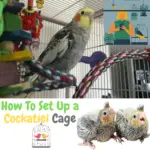
Do you want to get out of the house with your parrot but you don’t know how to go about it?
If you own a hooked beak, one day or another you will have to leave the house with it. Whether it is to go to the vet or simply to get some fresh air. You will then have to respect certain rules to prevent your bird from injuring itself or running away.
We will therefore explain to you exactly how to proceed in this article.
To go out with your parrot, there are two possibilities. You can either use a special harness for birds. Or use a parrot transport cage. It will be necessary to make sure to give treats and affection to his bird so that he feels safe.
Let’s discover these two methods together now!
Using a Parrot Harness
Step 1: Buy a harness that matches your bird
The harnesses are sold in different sizes (small, medium, and large). The label on each harness will specify which breeds each size is suitable for. There are often several different colors to choose from.
If you are not sure what size harness your bird needs, seek advice from a sales representative. It will help you choose the right size for your feathered friend.
Discover our collection of harnesses by clicking on the image below.
Step 2: Make your companion comfortable
Make your parrot comfortable to be handled. Use the treats and affection to gain her trust. Practice picking up your feather duster and touching its head, back, and wings. Your parrot must be comfortable in order to be able to accept the harness.
When training your tropical bird in handling, be as slow and gentle as possible. Work in short sessions of 10-15 minutes, once or twice a day.
Step 3: Let him get used to his leash
Let your pet inspect the harness to get used to it.
Place the harness next to him to help him feel comfortable around this new object. Give your bird ample time to look, approach, and touch the harness.
Use treats to reward your bird’s confidence and not to be afraid of the harness.
Watch your parrot closely as he inspects the harness. Indeed, some birds like to chew on harnesses, which can damage them.
Step 4: Teach him to put his head in the harness
Once your parrot is comfortable with the harness, slowly guide its head through the head element using a good treat. When his head is in the harness, give him the treat and remove the harness while he eats. Practice this action until your bird is calm when it puts its head in the harness.
Once he’s comfortable, keep the harness over his head while he eats the treat. This helps your parrot get used to the feel of the harness around its head and creates a positive association.
Learning the harness consists of teaching him to put himself in it voluntarily. It helps your pet to feel confident and ready to be in the harness. Never force your parrot when he is in his harness as this creates a negative association and he will be reluctant or afraid to wear it in the future.
How To Take Your Parrot Outside Safely
SOURCE:MARLENE MC’COHEN
Step 5: Place the harness on your bird’s wings
Place the harness over the wings and gently tighten the straps. Once your parrot is comfortable with the harness on its head, gently lift each wing up through the straps.
Praise your exotic bird and give it a treat after it allows you to put each wing in the harness. Adjust each strap so that it is snug, but not too tight, against your companion’s body.
The harnesses have 3 main parts. The head part is the smallest space in the front of the harness. The wing element includes the straps that surround each wing. The wing is separated into two parts, one for each wing, with a small strap that lies flat on the parrot’s chest. This is where the leash connects to the harness.
Practice putting on the harness in short sessions over a few weeks. Never rush your parrot and work at a pace that suits them.
Before putting on the harness, each time check that it is not damaged by chewing. Your feather duster can escape or be injured by a damaged harness.
Step 6: Attach the harness to your hand
Attach the harness to your hand while your bird enjoys the outdoors. Place your hand in the loop at the end of the leash and hold the leash, rather than just holding the leash in your hand. If you change hands or pass it to another person, keep the leash wrapped around your wrist as you do so.
Step 7: Constantly Observe Your Exotic Bird
Constantly observe your parrot when it is in the harness. Make sure it is safe from dangers such as cats, dogs, and cars. Watch where you are walking.
Avoid tying the harness to a perch. Indeed, an attached bird is defenseless against predators. Your parrot could also be injured by the perch if it tries to suddenly take flight.
Step 8: Take it gradually
Use the harness for 5-10 minute sessions to start. Start with outdoor sessions of just a few minutes and slowly work your way up to longer workouts. Note the length of your time outdoors.
Make sure your bird has enough time to rest after being in the harness and has access to Parrot food and water after each session.
How to Take Your Parrot Outside | Parrot Training
SOURCE:Howcast
Using a Parrot Transport Cage
Step 1: Choose a cage suitable for the size of your parrot
Choose a cage suitable for the size of your bird. For small birds such as cockatiels and conures, a 30cm × 30cm cage or support is adequate. Use a 60cm × 60cm cage for larger birds like cockatoos or Eclectus.
Make sure there is enough Parrot room for food and water, and for your bird to spread its wings.
Step 2: Secure the transport cage door
Use Pak o bird or Bird Travel Cage a mini-padlock or metal clip to secure the cage door. Many birds are experts at escapees and can learn to open cage and carrier doors. Prevent your bird from opening the cage door when he is outside by using a small padlock to connect the door to the cage wires. This means that the door cannot open without being unlocked from the outside.
You can use the same type of clip or lock that is used to secure parrot toys to a cage.
Step 3: Hide 3 sides of the cage
Place a towel on 3 sides of the Parrot cage. Use an old towel to cover the sides and back of the cage so that your parrot can see the outside from one direction. When your bird feels more comfortable outside, slowly pull the towel back.
You will be able to tell that your parrot is ready for the towel to be removed when it no longer seems afraid to be outside. At this point, you may even find that it is curious to discover the outside world.
While your parrot gets used to being outdoors, the towel helps it feel secure and also provides shade in hot weather.
Step 4: Place the transport cage wisely
Place the cage in a location that is both sunny and shady. Make sure your bird can be out of the sun when in the cage to avoid overheating. Under a tree seems to be a suitable place.
Step 5: Take it easy
Start with 5-10 minute sessions and observe your parrot up close in the outdoors. Always supervise him when he is outside to make sure he is calm and happy. Gradually increase the time you spend outdoors.
Many owners of exotic birds enjoy reading a book while their feathered companion enjoys nature.
If you take your bird outdoors for long periods of time, make sure the food and water containers in the cage or rack are full.
Questions About Parrot Aviator Harness or Going Outside?
SOURCE:Parrot Wizard
Transport your Psittacidae safely
As you can see, it is important to always keep an eye on your companion when you go out.
Thanks to this article, you are now able to easily go out with your feather duster in a relaxed manner.
In order to provide maximum comfort and safety when you go out. We offer you our transport cages.
Discover our collection of parrot transport cages by clicking on the image below.
Harness Training
SOURCE:ElleAndTheBirds
Related Article:
























